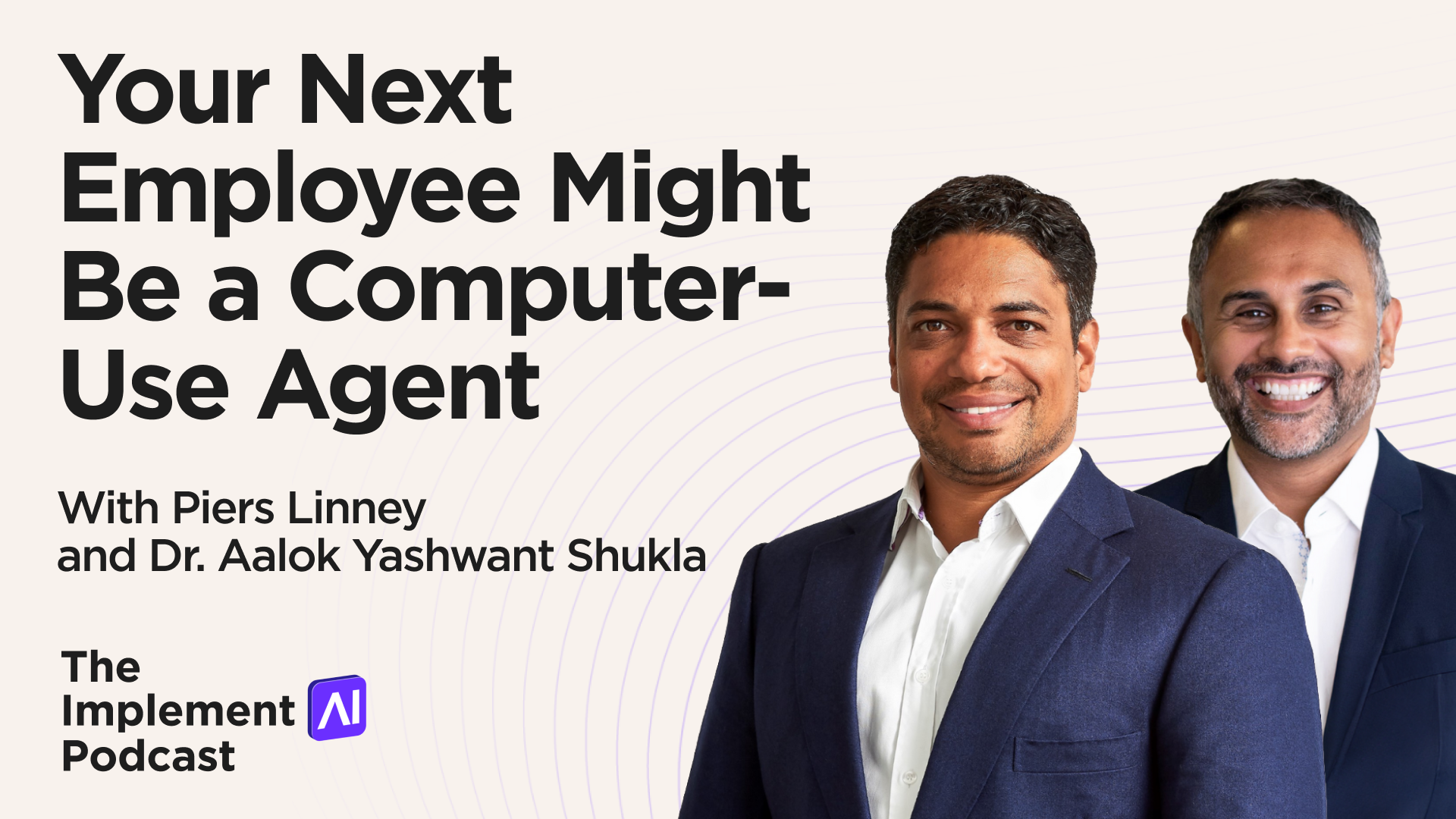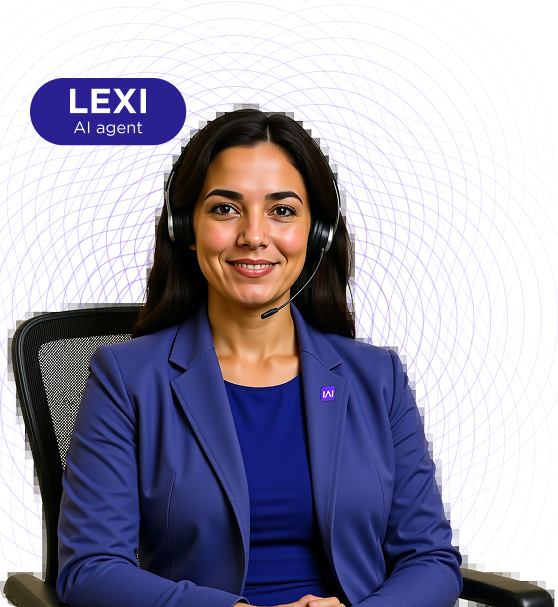The Implement AI Podcast #62 – Your Next Employee Might Be a Computer-Use Agent
August 31, 2025
Just a year ago, AI-generated video looked like a joke. Remember that spaghetti-eating “Will Smith” clip that went viral for all the wrong reasons?
Fast forward to now, and we’ve got Google’s Veo 3 pumping out cinematic-quality footage with synchronised dialogue, ambient sound, and production values fit for a Netflix trailer. Blink, and you’re behind. That’s the speed of the AI frontier, and it’s only getting faster.
In this episode of The Implement AI Podcast, hosts Piers Linney and Dr. Aalok Y. Shukla explore this warp-speed evolution of AI, not as spectators, but as builders. With their AI Operating System (AIOS) set to launch at their London event, Your Future Digital Workforce, they’re sharing hard-earned insights on what it really takes to implement AI in business.
Let’s dive in.
Welcome to Exponential Change
The AI news cycle has become so fast and wild that it’s almost impossible to keep up. But that’s kind of the point. What we’re witnessing now isn’t just growth; it’s exponential acceleration.
Take Google’s Veo 3. Just over a year ago, AI-generated video was a novelty grainy and glitchy, like the infamous Will Smith spaghetti clip.
Now? Piers described generating Hollywood-quality videos complete with water sounds, natural movement, and accurate lip-syncing. The difference in just 12 months is staggering.
This ties directly into a new trend they call “Vibe Marketing,” a mode of creative development where you don’t write code or fiddle with video editing software. Instead, you talk to your AI like a marketing director: “Here’s the campaign goal, the audience, the tone. Now show me five options.” The result? Rich content at scale, powered by voice. Forget A/B testing; think A-to-Z testing.
From Hype to Hardware
Beyond flashy videos, the conversation turns to the emerging operational edge. This is where AI shifts from public demos to internal systems. One standout development: “computer use” agents.
These are more than just chatbots or assistants. These are full-on digital workers that can open software, log in with two-factor authentication, extract data, move it between apps, and even read SMS messages on virtual phones. They’re capable of replacing repetitive workflows, especially in companies burdened with legacy systems or manual operations.
Many jobs today are just data shuffling. These AI agents can automate that, freeing up humans to focus on creative problem-solving, strategy, and growth.
Vertical vs. Horizontal vs. Hybrid AI
If there’s one strategic conversation every business leader should hear, it’s this one.
Piers and Dr. Aalok break down three key models of AI deployment:
- Vertical AI: These are specialized agents built for a single function. Think of an AI that drafts emails or summarizes legal documents. They’re quick to deploy but often siloed.
- Horizontal AI: This is the long game. A unified platform where agents can collaborate, share context, and scale across departments. It minimizes complexity, reduces vendor sprawl, and centralizes data intelligence.
- Hybrid AI: The best starting point. Deploy 1-2 agents around a “hero workflow,” like Lexi, their AI sales agent that answers calls, qualifies leads, books meetings, and sends PDFs, all fully integrated with Outlook, WhatsApp, and internal tools.
Their advice: don’t deploy five disconnected AI tools. Start with one or two well-scoped agents, learn how they interact with your processes, and scale from there.
Real-World Use Cases: Meet Lexi
Lexi, Implement AI’s flagship support agent, is more than just a proof-of-concept; she’s a blueprint for what AI agents can do right now. Lexi can:
- Engage prospects on the website
- Qualify leads
- Book meetings directly into calendars
- Share follow-up documents via email and WhatsApp
- Remember past conversations
She’s available 24/7 and designed to enhance human sales and support teams, not replace them. And this is crucial. The real opportunity isn’t just in reducing cost. It’s in increasing capacity, reach, and customer satisfaction without scaling headcount linearly.
The Rise of Multi-Agent Collaboration
Another highlight is the emergence of MCN (Multi-agent Collaboration Networks), a standard for enabling AI agents to pass context and goals between each other, even across platforms. This interoperability is vital for businesses that don’t want to get locked into proprietary systems.
Imagine an AI researcher identifying a market opportunity, and passing the lead to a sales agent, who then triggers a contract agent, all without a human lifting a finger.
Thanks to evolving standards like MCP and MCN, we’re on the point of this becoming a reality.
Strategic Advice for Business Leaders
If you’re wondering how to get started, here’s a quick playbook straight from the episode:
- Identify Your Hero Workflow: Focus on one business process that adds real value: sales follow-up, customer onboarding, reporting, etc.
- Scope Your Agents Properly: Don’t build a “super agent.” Break tasks down into logical, repeatable components and assign agents accordingly.
- Design Modularly: Build like LEGO. Use AI tools and integrations that can be swapped out as technology evolves.
- Embrace Hybrid First: One or two agents, fully integrated and delivering measurable results, are worth more than ten fragmented tools.
- Let People Focus on What Matters: AI isn’t about replacing jobs; it’s about removing the tedious stuff so your team can focus on strategy, insights, and innovation.
Final Thoughts
AI isn’t coming; it’s already here. The real challenge now isn’t access to technology but knowing how to use it strategically. The winners won’t be the ones with the flashiest tools. They’ll be the ones who start small, stay focused, and scale smart.
Listen to the new episode on:
- Apple: https://bit.ly/43K8S2w
- Spotify: https://bit.ly/4mWeEXQ
- YouTube: https://bit.ly/4kXywrD



